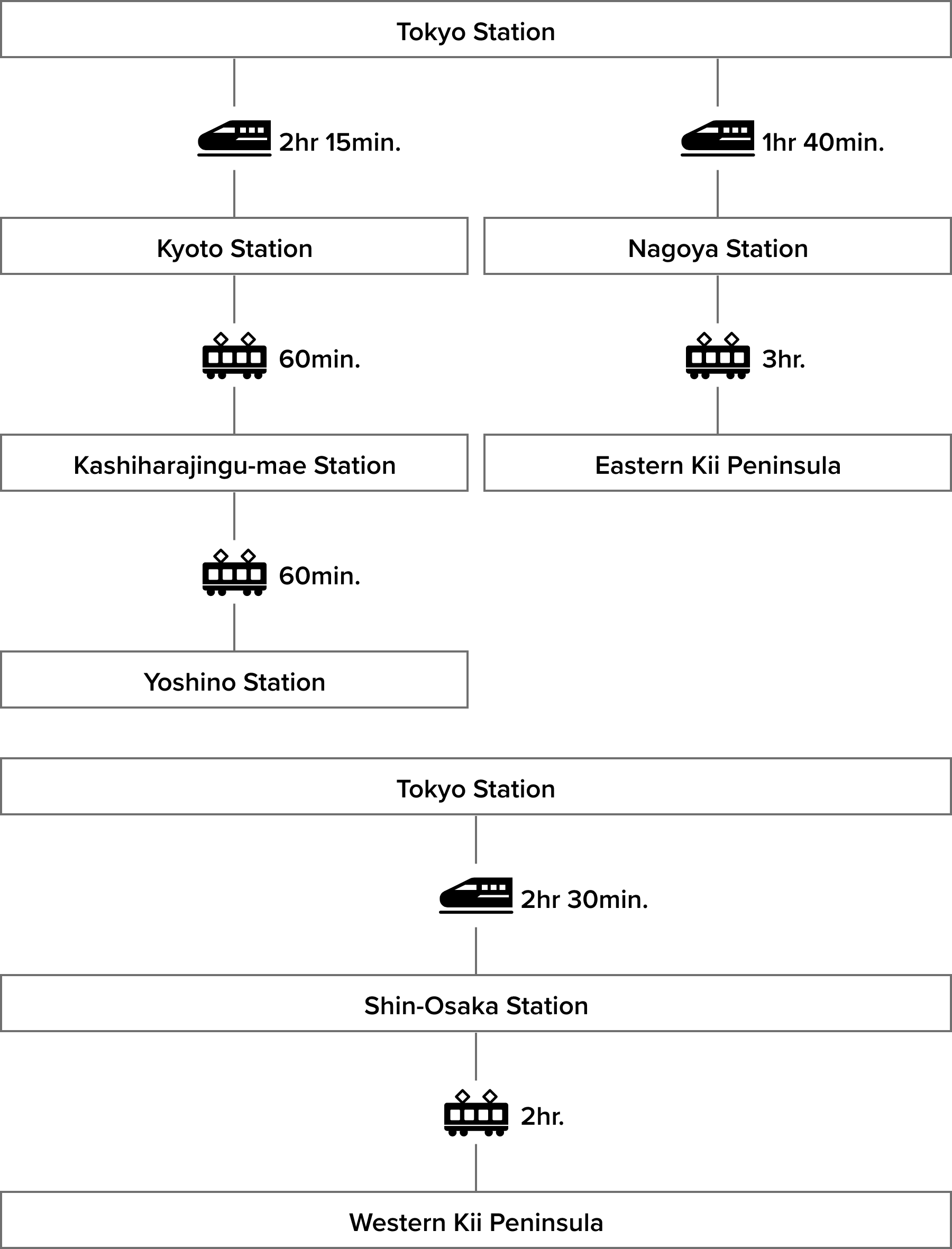| From Tokyo: | 4-6 hr |
| From Nara: | 1.5-4 hr |
How to Get There
Yoshino-Kumano National Park straddles parts of Mie, Nara and Wakayama prefectures and is known for its natural scenery and religious walkways. Much of the park overlaps with sacred sites and pilgrimage routes in the Kii Mountain Range, a UNESCO World Heritage site. The northern area of the park includes Mount Yoshino, Japan’s most famous cherry blossom-viewing location, while the southern Kumano area on the Kii Peninsula contains three main shrines and a network of pilgrimage routes. Although the park has convenient public transportation, including the Kisei Main Line that runs along the coast of the Kii Peninsula, a rental car will significantly reduce travel time. It's most rewarding to walk a sacred route used for centuries by faithful pilgrims.
From Tokyo
To get to Mount Yoshino, take the Tokaido Shinkansen to Kyoto Station (2 hr 15 min), change to a Kintetsu Railway express train or limited express train headed for Kashiharajingu-mae Station, and then transfer at Kashiharajingu-mae Station to a Kintetsu limited express train headed for Yoshino Station (2 hr). The eastern Kii Peninsula is most quickly accessed from Tokyo by changing trains at Nagoya Station. Take the Tokaido Shinkansen to Nagoya Station (1 hr 40 min), transfer to the JR Nanki limited express to the Kii Peninsula, and alight at the station closest to your destination (3 hr). For the western Kii Peninsula, it’s fastest to take the Tokaido Shinkansen to Shin-Osaka Station (2 hr 30 min), transfer to a JR limited express train heading to the Kii Peninsula and get off at the station closest to your destination (2-4 hr). Once you’ve arrived at the train station, take a bus from either Nara Kotsu, Meiko Bus, Ryujin Bus, or Kumano Gobo Nankai Bus (see “Getting Around” below).

From Nara
Mount Yoshino makes a great side trip if you’re staying in Nara, especially during the cherry blossom season in spring or the autumn foliage season. Take an express train on Kintetsu Railway from Nara Station, transferring at Yamato-Saidaiji Station and Kashiharajingu-mae Station along the way, and alight at Yoshino Station (1 hr 35 min). For the Kii Peninsula, take the Yamatoji Line to Tennoji Station in Osaka (30 min), change to the Kuroshio limited express train, and take it to your destination (3 hr).

Getting Around
Though a car makes it easier to explore the large park fully, the public transportation network also provides excellent access to popular areas. If you plan to rent a car, it’s best to traverse long distances by train (such as between Tokyo and Osaka or between Nagoya and the city of Kumano), then rent a car close to a major train station near your destination. On the Kii Peninsula, Shirahama, Kumanoshi, and Shingu stations have car rental companies nearby and make ideal bases for exploring the Kumano area of the park. If you prefer to use public transportation, the JR Kisei Main Line runs along the coastal perimeter of the Kii Peninsula. The interior of the peninsula is served by buses from Nara Kotsu, Meiko Bus, Ryujin Bus, and Kumano Kotsu. Many of the companies’ routes and bus stops overlap. The Tanabe City Kumano Tourism Bureau website provides English-language information on the bus networks, including maps, timetables and prices. The website also provides maps and other information on the pilgrimage routes, including itineraries for everything from half-day walks to multi-day treks linking the sacred sites.


















